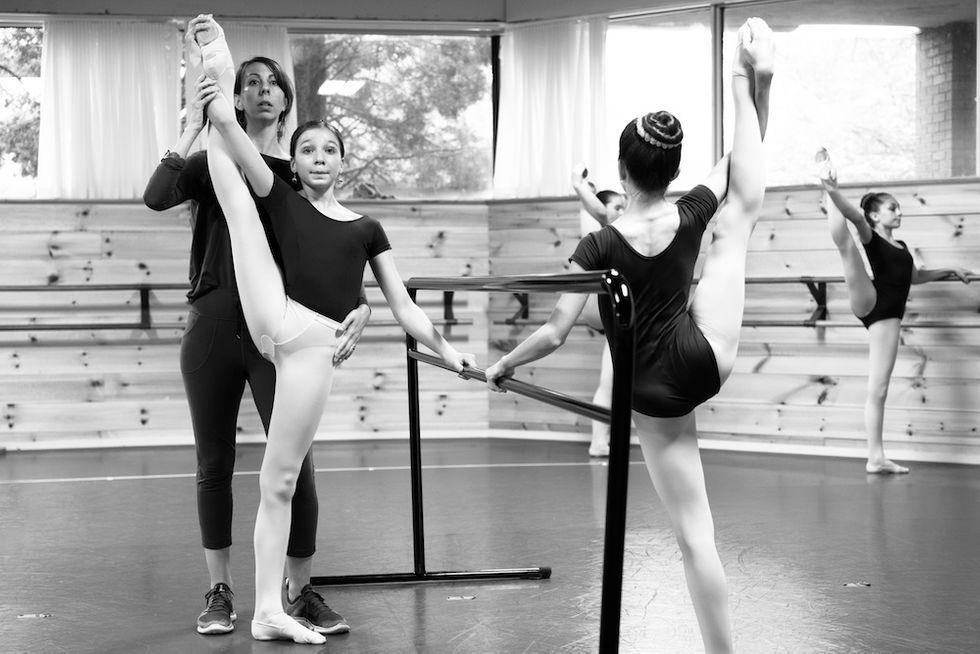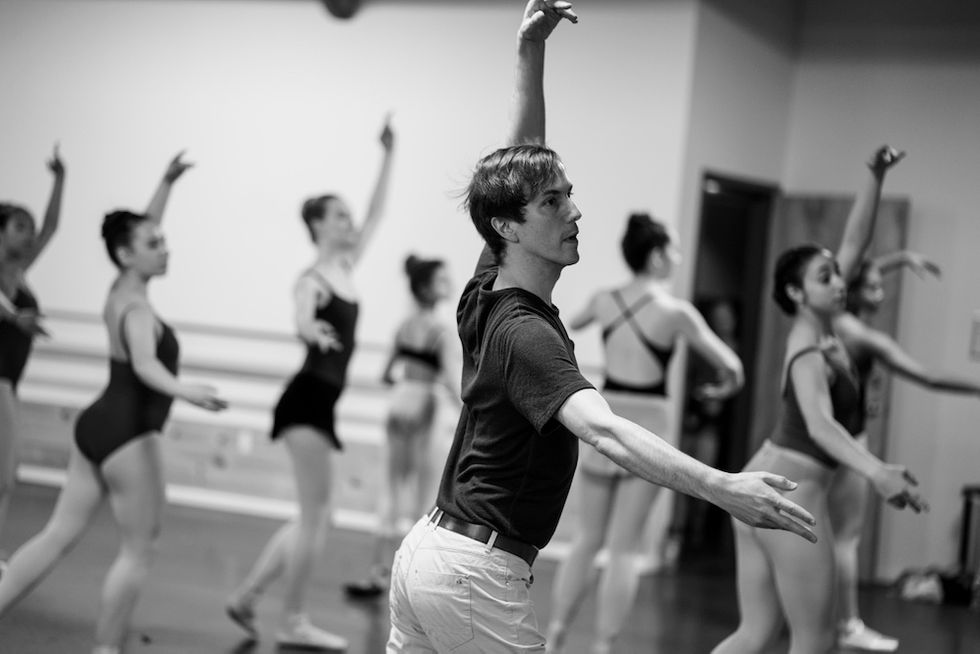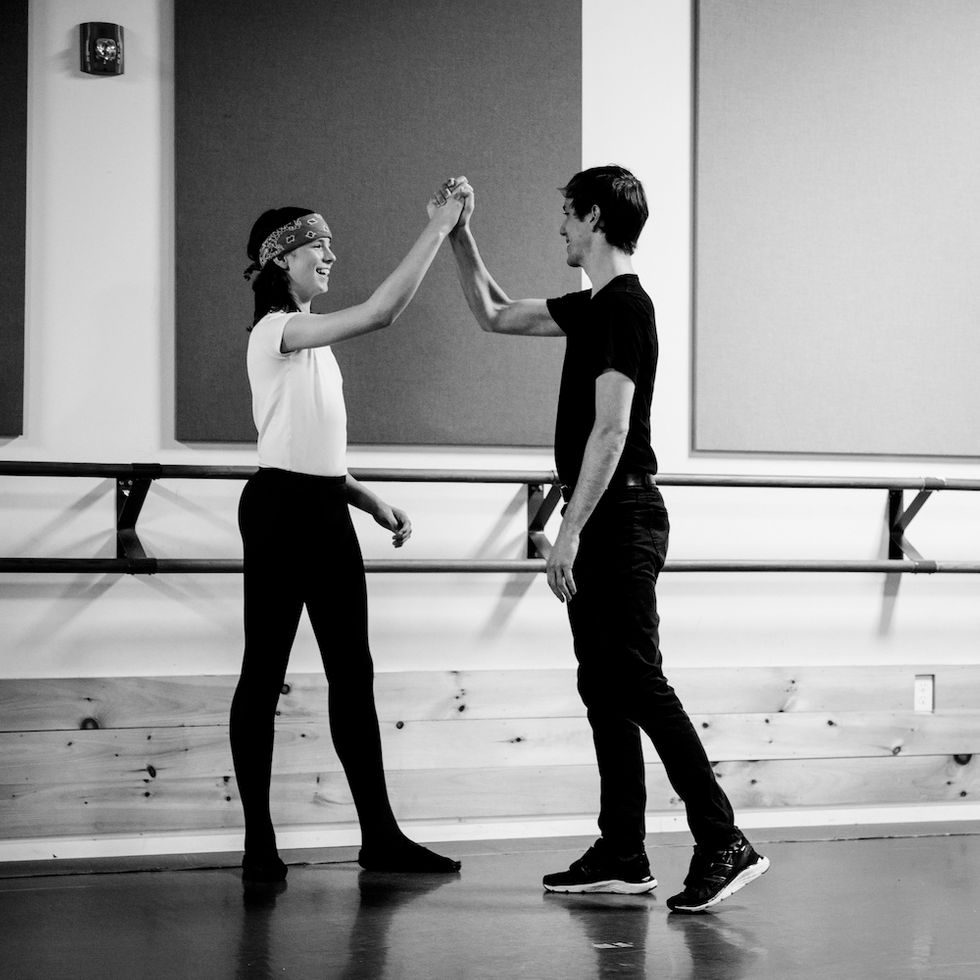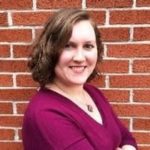
What makes someone ready to leave a successful performance career to buy a dance school? For Nicholas and Shayne Mishoe, that turning point came while Nicholas was touring in the Netherlands with the Dutch National Ballet. “Dancing late into the night on a hard stage, getting on a bus and driving a couple hours and doing the whole thing again the next day, for a month—one night, I thought, ‘I’ve had enough of this,'” Nicholas says.

“We train dancers to be accountable for their own dancing,” says Shayne Mishoe. Photo by Sori Gottdenker, courtesy of ADA
“The life we were living didn’t feel sustainable long-term,” adds Shayne, who was performing on a project basis in Amsterdam, while also teaching ballet, Pilates and Gyrotonic. Operating their own school had always been their dream, and after Nicholas’ bus tour through Holland, the stars aligned. Shayne knew that the founder of her childhood studio in New Jersey, where her mother has also taught since the early 1990s, had been thinking about selling. She and Nicholas talked it out, made the phone call and set the plan into motion.
The Mishoes officially took over The Academy of Dance Arts in Tinton Falls, New Jersey, in 2008. In their decade behind the wheel, the couple has taken a school with an already stellar reputation to the next level. Among the changes they’ve implemented: an invitation-only merit-scholarship track helps career-focused students prepare for professional life, while new conditioning classes produce stronger, more anatomically aware dancers. These days, ADA alums perform with American Ballet Theatre, Pennsylvania Ballet and The Washington Ballet; train at the School of American Ballet (summer and year-round); and have gained acceptance to college programs like the Ailey/Fordham BFA Program and The Juilliard School.
Shared Histories
Shayne and Nicholas met as students at Boston Ballet’s summer program in 1999. Both had just graduated high school, with Shayne having done her formative training at ADA, while Nicholas attended University of North Carolina School of the Arts. After their summer together, Nicholas went on to join Boston Ballet II, and then the main company. Shayne spent a year at Towson University in Maryland, before returning to Boston to attend Boston Ballet School. In addition to occasionally performing in the BB corps de ballet, she did project work in the area, and became certified to teach Pilates and Gyrotonic. The pair married shortly before relocating to Amsterdam.

“YAGP lets our dancers experience an intensive coaching period. We treat it as another performance opportunity,” says Nicholas Mishoe. Photo by Sori Gottdenker, courtesy of ADA
ADA founder Jennifer Church was happy to give her blessing when her former student and her husband reached out about purchasing the studio. “Shayne understood the way I ran the school,” Church says. “I also knew that she and Nicholas were great teachers; they’d guest-taught for me. They have such a good rapport with the kids. Their style is gentle, but effective.” Church worked with the Mishoes on a plan to finance more than 90 percent of the purchase price through the business; the down payment came from an investment account the couple had in place. Within four years, they’d paid in full.
Since the day Church opened her school in 1985 in a small building in downtown Red Bank, New Jersey, ADA’s philosophy has remained consistent. In a nutshell: “We care about technique,” Nicholas says. “Our students learn to dance well.”
Shayne elaborates, “We train dancers to be accountable for their own dancing. We give them the tools and the knowledge. They can take responsibility for what they do with that. That’s always been at the heart of ADA’s approach.”
Classical Foundations
Under Church’s leadership, ADA had a number of Royal Academy of Dance–registered teachers. However, the Mishoes have moved away from the regimented RAD syllabus. In addition to craving more creative freedom in their own teaching, Shayne and Nicholas felt that being exposed to a variety of methodologies would better prepare their students for professional life. Now, only their younger levels complete RAD examinations, every other year.
All of ADA’s dancers are trained with common ideals in mind: “Clear lines, correct alignment and musicality,” Shayne says. “Everyone on our faculty has their own set of tools to get those concepts across.”
Out of approximately 150 scheduled classes, Shayne says at least 80 are ballet-related. ADA’s ballet base is supplemented by a modern program that includes Graham and Horton techniques; jazz; contemporary; hip hop; and tap classes; and an array of body-conditioning courses. Pilates and yoga are available for dancers 9 and up, while older students can also enroll in private Gyrotonic training with Shayne.

Photo by Sori Gottdenker, courtesy of ADA
“All of those other classes feed into how the kids approach ballet,” Shayne says. “Those who take modern understand how to use their backs and drop their weight. The ones in Pilates, Gyrotonic and yoga build powerful cores and understand which muscles do what. It all helps us produce strong, versatile dancers.”
The proof is in the pudding: In 2018, ADA took four ensembles and 12 soloists to Youth America Grand Prix’s New York City semifinals. Two of the ensembles advanced to the finals, along with one of the soloists, while several students placed in the top 3 or top 12 at the semifinals. Yet, despite this solid showing, Nicholas and Shayne don’t think of ADA as a competition studio. “YAGP lets our dancers learn new solo and ensemble material, and experience an intensive coaching period,” Nicholas says. “We treat it as another performance opportunity.” (Additional chances to perform include the school’s end-of-year production and the fall and spring shows put on by Company of Dance Arts, ADA’s affiliated troupe.)
The total number of enrolled students has dropped since the Mishoes took over—but the percentage of dancers taking multiple classes has skyrocketed. “Instead of having 500 students, with a lot training once a week, we have about 250, with many training 25 hours a week,” Shayne explains. The studio’s invitation-only track, created in 2012, is partly responsible for the shift. In order to join ADA’s pre-professional track, and to be eligible for merit scholarships, dancers must follow a set curriculum. “Our younger kids see the older dancers—how hard they’re working and how often they’re here—and get inspired to do more themselves,” Shayne says. “We’re not a conservatory; everyone is welcome, and we do still have many recreational students. But we want to be training serious dancers at the same high level as those other schools.”
A Communal Vision
The Mishoes’ ideology as business owners dovetails with their philosophy as teachers. They have an open-door policy and try to check in with everyone in the building daily. (They employ 16 teachers, 4 accompanists, 3 office staffers and a rotating guest faculty.) “As a dancer, I constantly felt like I didn’t have enough information to really thrive and do my best. There was a divide between the people running the show and the people performing,” Nicholas says. “So the main thing I’m trying to achieve as a boss is that my employees have all of the information they need. If everyone is on the same page, everyone can contribute to making the writing on that page as good as possible.”
Both Nicholas and Shayne teach and handle administrative tasks, and they coach and lead rehearsals during YAGP and performance seasons. Being so heavily invested can make it difficult to maintain work-life balance—especially as a married couple. “Shayne and I work well together, bouncing ideas off one another and supporting each other in the roles we’ve taken on,” Nicholas says, “but the studio can overtake our personal life. It’s a challenge to make time to do things together that aren’t work-related. Luckily, we really love what we do.”
“There’s a big picture to running a school,” Shayne says, “and we want everybody to understand where they fit in this cohesive whole. Our faculty are happy to be with us, and they’re happy with the amount of freedom that we give them. We trust and respect them, and we know that the material being given is relevant, safe and delivered in an inspiring way. Our passion and our teachers’ passion helps us train and motivate our dancers to be their personal best.”




